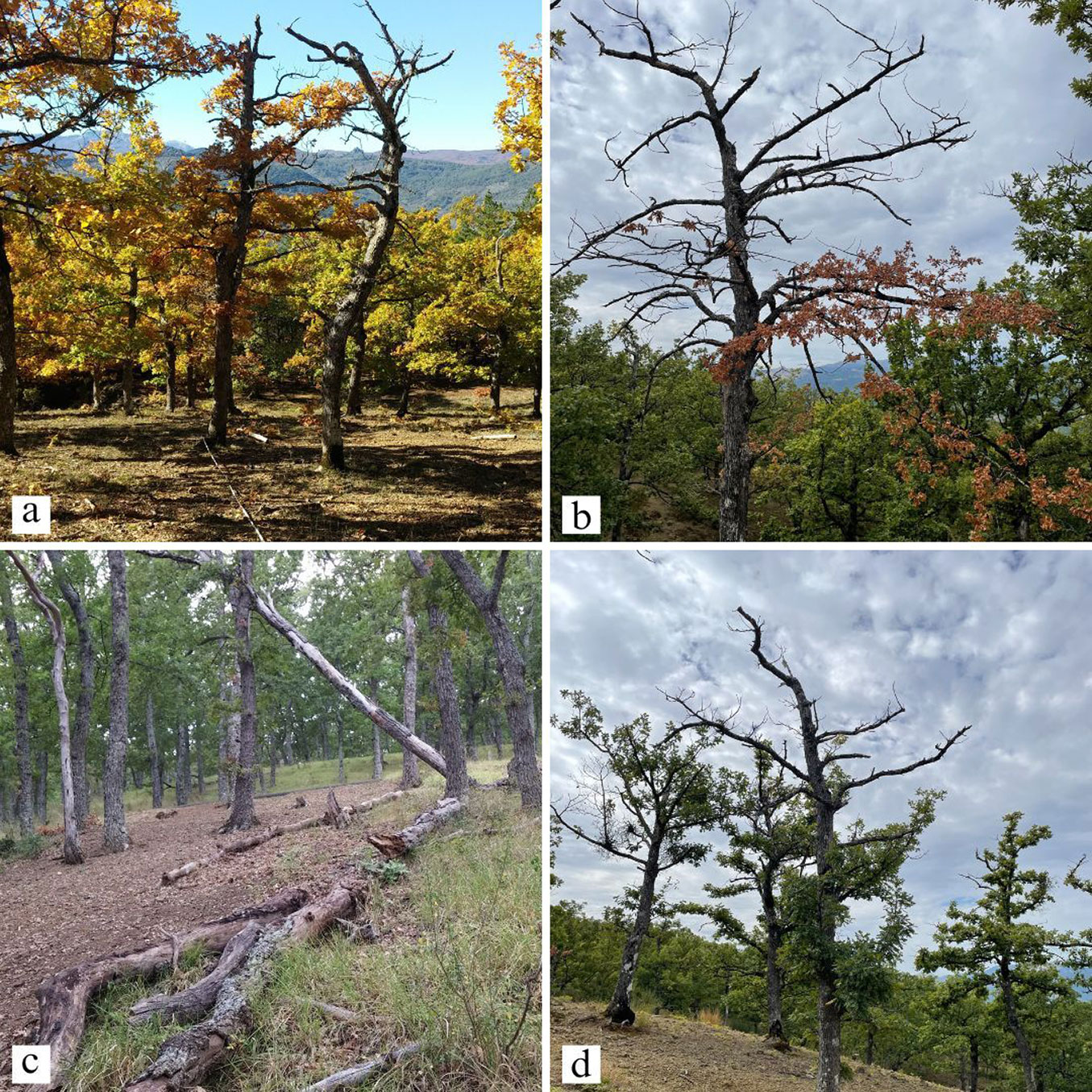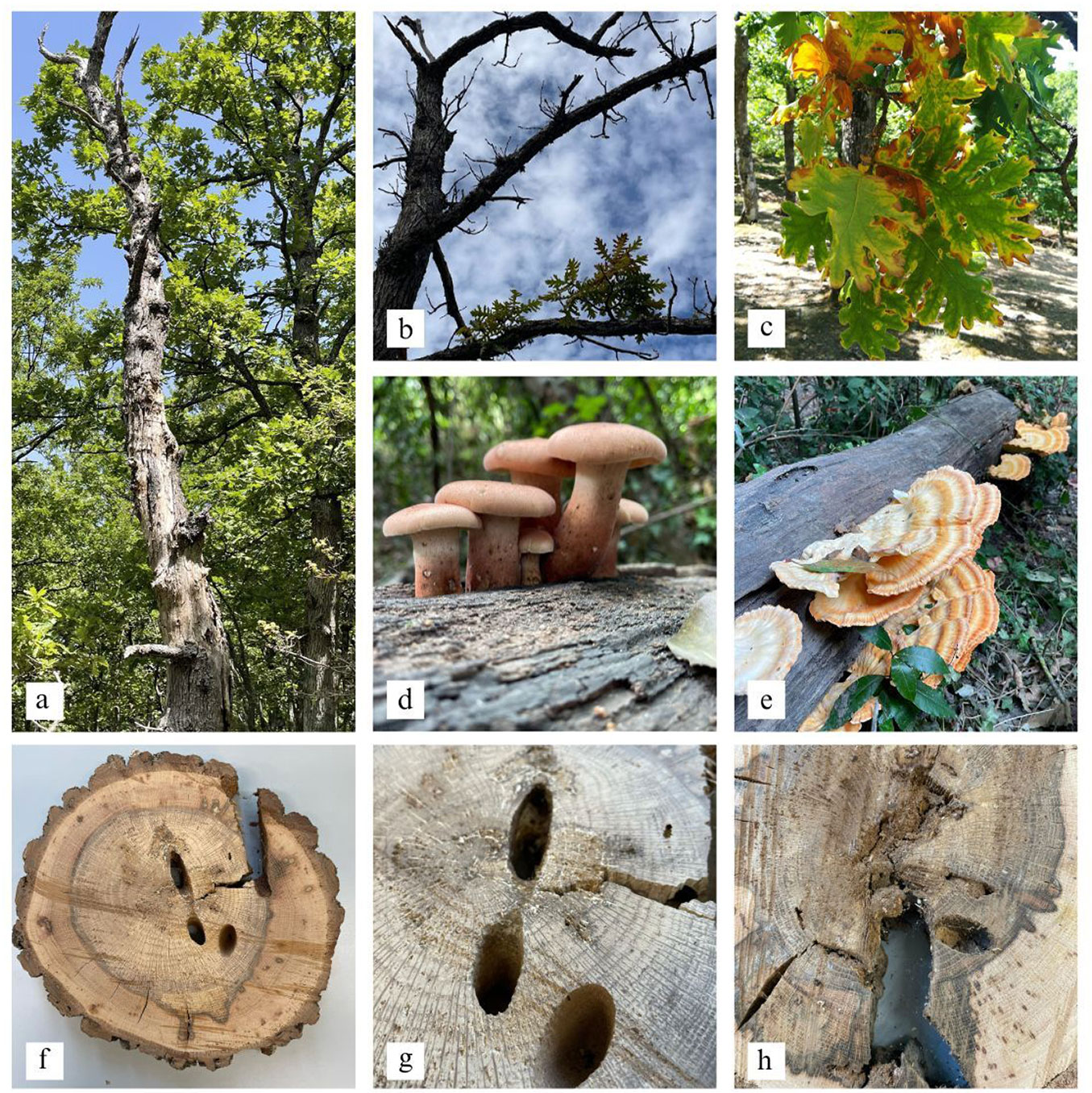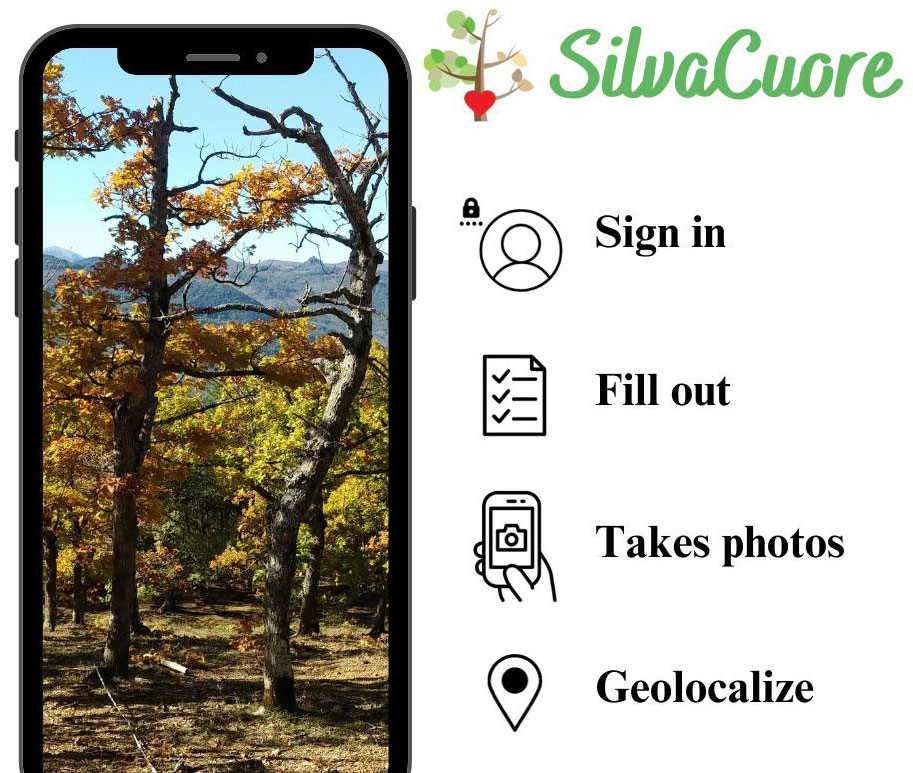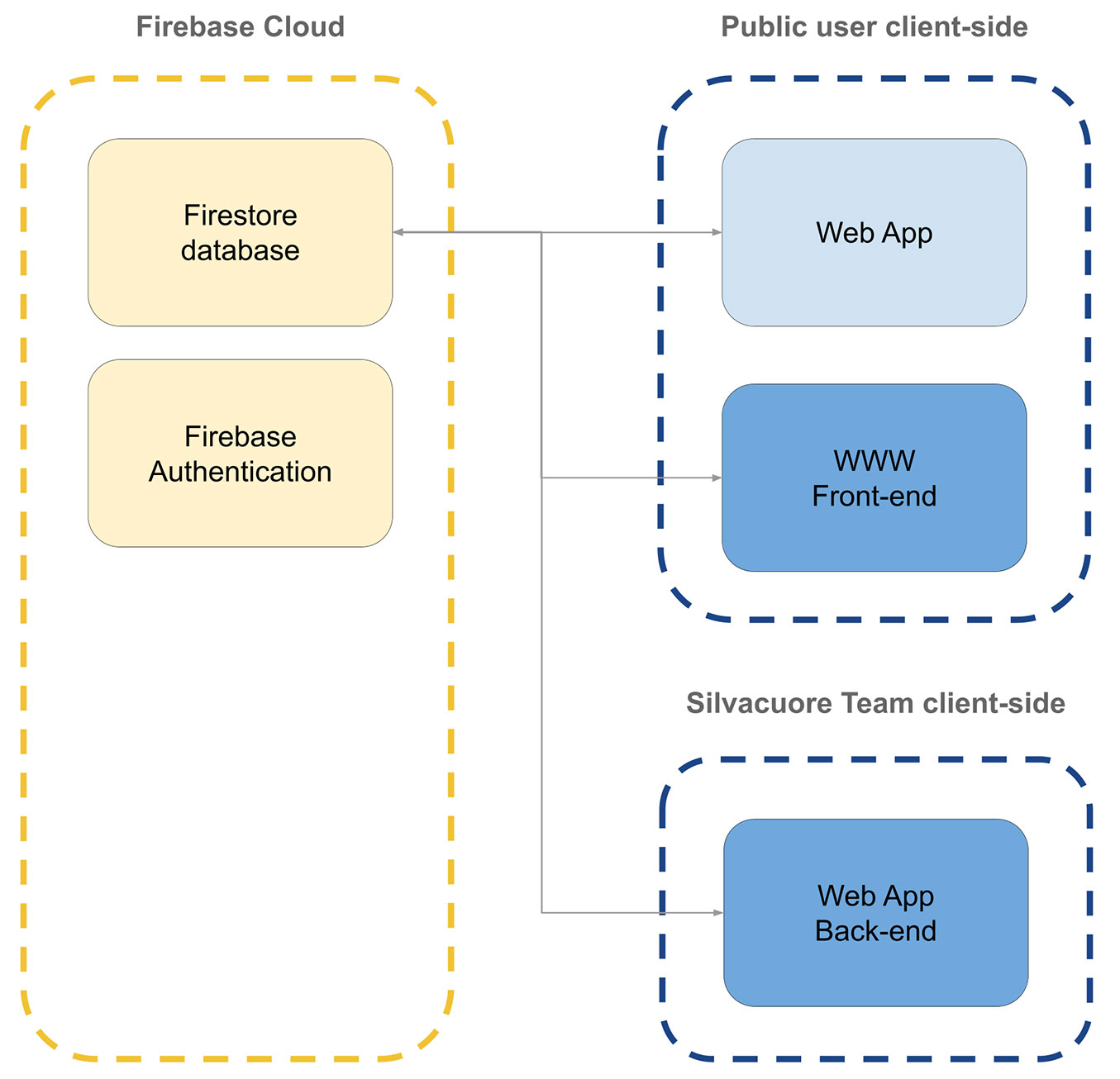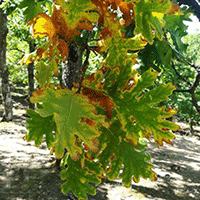
SilvaCuore: a web-application to monitor the health status of Italian forests
iForest - Biogeosciences and Forestry, Volume 17, Issue 5, Pages 317-322 (2024)
doi: https://doi.org/10.3832/ifor4562-017
Published: Sep 30, 2024 - Copyright © 2024 SISEF
Review Papers
Collection/Special Issue: Project LIFE MODERn(NEC)
Workshop "Climate change and forest health monitoring in Italy" - Rome (Italy) May 5, 2023
Guest Editors: Bussotti F, Pollastrini M
Abstract
In the current context of climate change, this paper provides a brief overview of climate-vegetation interactions in the Mediterranean basin, where global warming and aridification trends are predicted to intensify. Rising temperatures coupled with extreme drought events have notable impacts on forest ecosystems, triggering dieback and mortality phenomena worldwide. The health status of forest vegetation may be assessed by either ground surveys or remote sensing. Several investigations of declining oak forests in the Apennine region have shown that the drought vulnerability of Mediterranean oaks is dependent on differences in access to deep soil water pools, which can be related to differences in rooting depth, tree size and growth rate. Forest dieback is widely reported in Italy, but the extent and overall distribution of this phenomenon have not yet been well defined. Thus, understanding the future dynamics of forest stands has several key objectives: inventorying declining forest stands to gain insight into the phenomenon and create a national-level database; locating these stands to allow monitoring of their evolution over time; and monitoring to allow planning of mitigation measures, as well as recovery and adaptation strategies. This background led to the implementation of SilvaCuore, the first web application designed in Italy to report forest health status. Silvacuore is a web application developed with the aim of improving the link between citizens and the scientific community by contributing to the development of a valuable scientific database. The direct involvement of citizens in forest preservation offers an interesting perspective because the innovative use of technology can tap into citizens’ growing enthusiasm for environmental topics. Thus, SilvaCuore may be viewed from a dual perspective as a resource for the scientific community and as a unique opportunity for citizens to take an active role in research activities (Citizen Science project).
Keywords
Climate Change, Citizen Science, Drought, Forest Dieback, Mediterranean Environment
Introduction
Increasing aridity, largely driven by higher temperatures and reduced precipitation, is likely to undermine the health of forest ecosystems. Experiments and observations suggest that the resilience of many forests is likely to be threatened as climate change progresses, altering their structure and functions and reducing their ability to provide ecosystem services ([6]). Increasing drought conditions coupled with other biotic and abiotic drivers are synergistically leading to responses in tree morphology, physiology, growth, reproduction, and forest mortality in different areas of the Mediterranean Basin. An international scientific survey found that forest mortality phenomena induced by drought conditions are leading to a partial or total conversion of vegetation patterns in different biomes; that is, forests characterized by species specific to more humid environments are evolving into communities of species that are detectable in drier environments ([6]). In response to the exacerbation of extreme climate events, the resilience of many ecosystems will likely be exceeded ([27]), although some forest populations are more adaptable to seasonal drought periods and/or irregular rainfall regimes ([20]). The Mediterranean region is an extremely important biodiversity hotspot that is likely to experience arid conditions that contribute to increased forest vulnerability ([11], [29]). It is crucial to establish a database of declining forests in order to carry out monitoring and adaptive management activities.
Forest dieback and mortality
Climate-induced forest mortality is a rising global phenomenon ([1]) at both the regional and local levels ([4], [26], [41]) and has major implications for the functioning of these key ecosystems ([3]). Various local surveys have reported an increased rate of tree mortality in response to drought throughout Europe ([10]). Caudullo & Barredo ([14]) reported 293 episodes of forest mortality in Europe over the period 1970-2019. Die-off phenomena as a consequence of severe water shortages have been reported, mostly in drought-prone ecosystems such as Mediterranean forests ([2], [25]). Diverse scientific investigations conducted in deciduous and coniferous forests highlight the widespread occurrence of these phenomena, e.g., Abies alba Mill. and Pinus sylvestris L. ([35], [45]), Pinus pinaster Aiton. ([21], [33]), Quercus robur L., Quercus pubescens Willd. and Fagus sylvatica L. ([12]), Quercus frainetto Ten. and Quercus canariensis Willd. ([40]), Pinus nigra J. F. Arnold ([23]), Pinus pinea L. ([34]), and Quercus robur L. ([36]). Tree mortality and forest decline are increasingly common in Italy ([22]), where the most affected forests are deciduous oak forests (Quercus cerris L., Quercus pubescens Wild., Quercus frainetto Ten., Quercus robur L.). Pollastrini et al. ([37]) outlined the impact of the 2017 summer drought on populations of diverse representative species in central Italy (Fagus sylvatica L., Quercus pubescens Willd, Quercus cerris L., Quercus ilex L., and Phillyrea spp.) and highlighted different responses and recovery capacities after disturbances. The phenomena of forest decline and mortality have also affected oak forests in the southern Apennines, for which dendro-isotopic and wood-anatomy investigations are already underway. The affected forests include the Gorgoglione mixed forest, which is dominated by Quercus cerris L. and Quercus pubescens Willd. ([19]), and the high forests of San Paolo Albanese and Oriolo, both characterized by Quercus frainetto Ten. ([17], [18], [39] - Fig. 1). Diffuse phenomena of forest decline and mortality have affected lowland oak forests in recent years as well. In the past, these forest populations have been intensively managed, which reduced their extent and fragmented their natural distribution, making the entire ecosystem extremely vulnerable to climate change.
Fig. 1 - Photographies showing the studied forest dieback episodes: (a-b-d) San Paolo Albanese, Q. frainetto Ten. pure forest, located in the Pollino National Park (Southern Italy); (c) Gorgoglione, Q. pubescens Willd. - Q. cerris L. mixed forest, located in the municipality of Gorgoglione (Southern Italy). Both forests exhibit phenotypic decline symptoms since the early 2000s.
Functional mechanisms
Dieback symptoms typically consist of a marked reduction in tree vigor (e.g., shoot death and leaf drop, epicormic shoot production, branch desiccation, longitudinal bark cracking), growth decline, and high mortality rates (Fig. 2). Two major mechanisms are involved in tree dieback and mortality: hydraulic failure and carbon starvation ([16], [31]). Hydraulic failure is related to the conductivity loss induced by embolism, that is, it occurs when transpiration water loss is greater than absorption by roots, causing pressure in the xylem to become increasingly negative. Beyond a given threshold value, the pressure reduction causes the formation of gas bubbles in the xylem conduits (cavitation), which then diffuse into the vascular system (embolism) and impede water transport. Carbon starvation occurs as a consequence of prolonged stomatal closure, resulting in a negative carbon balance ([30], [42]). The root system of trees plays a key role in their resistance and adaptation mechanisms to climatic stress. A recent study ([39]) showed that non-declining oaks, due to their deeper root system, are able to extract more water from the underground water supply than declining ones with shallower root systems; the former therefore exhibit a greater probability of survival during severe drought periods. Thus, different access to deep water reserves may influence trees’ responses to climate stress. As evidence of this phenomenon, Colangelo et al. ([18]) reported that declining trees exhibited lower water-use efficiency and lower growth than healthy trees. The high transpiration rates behind lower water-use efficiencies suggest a less conservative water-use strategy in declining individuals. Plant size may also play an important role. It has been observed that taller trees respond better to drought, likely due to their greater ability to extract water from the groundwater supply because of their deeper root systems ([18]). Another key issue that needs to be monitored concerns anthropogenic nitrogen emissions. Increased nitrogen deposition may lead to beneficial effects on oak physiology in terms of both water-use efficiency and carbon uptake ([24]). A meta-analysis revealed that greater nitrogen availability could enhance the formation of a more efficient xylem structure, leading to a greater ability to cope with drought-induced embolism ([7]). However, another relevant effect is CO2 fertilization. Research studies have shown that a high concentration of atmospheric CO2 has direct effects on the structure and function of ecosystems, including effects on tree physiology and growth ([38]); it appears to enhance productivity and water use efficiency ([28], [15]). Many studies have reported that high CO2 can attenuate the negative impacts of drought on trees ([46], [43]). Despite the significance of these effects of CO2 on growth, the underlying mechanisms are still not well understood. The relationship between water use efficiency increase and biomass-induced increase in water uptake plays a key role in evaluating the response of vegetation to drought, emphasizing the importance of gaining a better understanding of the impacts of rising CO2 levels on trees.
Fig. 2 - Principal symptoms of decline in oak trees: (a) longitudinal bark cracking, stem desiccation; (b) epicormic shoot production, branch desiccation, shoot death and leaf drop; (c) leaf withering and yellowing; (d-e) subsequent pathogen attack, i.e. macroscopic fungi; (f-g-h) subsequent pathogen attack, i.e. insects.
Forest’s health monitoring
Assessing the health status of forest ecosystems by monitoring dieback and mortality phenomena is fundamental for developing and implementing measures to mitigate climate impacts as well as recovery and adaptation strategies. The vegetative health status of forests can be evaluated by either ground-based surveys or remote sensing using images captured by drones and satellites. Tree-ring sampling provides insight into the amount of wood that is formed from the stem, which may be related to biomass gain and carbon uptake ([5]). The advantages of tree-ring growth data include high temporal resolution, the possibility of obtaining long-term series, and accurate dating. Conversely, due to their limited spatial resolution (at the tree level), these data can only provide insights into forest responses to climate at the local scale. Intensive field labor is required to collect wood samples of tree rings in addition to time-consuming laboratory work to cross-date and measure woody material. In contrast, satellite data are broadly available and may allow “near real-time” assessments of changes in forest health over large geographic areas ([32]). Compared with traditional dendro-chronological surveys, remotely sensed vegetation indices may report information that exhibits greater spatial extent and temporal resolution and can range from daily to yearly. For instance, the European Forest Condition Monitor, an interactive web-based information tool based on remote sensing, is a valuable instrument for detecting areas of forest decline ([9]). Nevertheless, it is crucial to validate remotely sensed information by testing the coupled/uncoupled relationships among the most reliable dendro-anatomical traits. Ground-based data and satellite-derived measures may provide complementary insights into forest health. Combining the strengths of these approaches has great potential to address scaling issues among individual plants and ecosystem responses ([8], [44]). An applied case can be found in Bosco Capillo in San Paolo Albanese (Southern Italy), which was investigated as part of the PON OT4CLIMA project. This project’s primary goal was to examine the stress factors that undermine the forest’s survival through a joint remote and ground-based approach. A coupled approach based on variables associated with forest productivity, recorded both on the ground (e.g., basal area increment) and from satellites (vegetation indices such as the normalized difference vegetation index), can thus be used for retrospective modeling of the impact of drought stress on forest productivity and tree growth to improve the knowledge and prediction of drought-induced decline in forest communities ([13]).
Many scientific activities and projects have been conducted in recent years in lowland forest populations, such as the Oriented Regional Reserve “Bosco Pantano” in the Policoro area (Basilicata, Southern Italy) and Ticino Park (Lombardy, Northern Italy). These projects have the common denominator of the preservation and restoration of these areas through investigation and monitoring. Researchers have employed multidisciplinary approaches to understand the relationships among climate and biotic stress responses and individual genetic traits. In recent years, efforts have focused on interventions involving the production of native seed material from acorns collected from trees with wide genetic variability to be employed in subsequent renaturalization operations.
Forest dieback networking
Several research institutions around the world are currently undertaking active initiatives and scientific projects that focus on both mapping and monitoring the phenomenon of forest loss and its relationship to other environmental factors. For example, the International Union of Forest Research Organizations (IUFRO) Task Force is conducting activities to develop a global multidisciplinary monitoring network. Applications developed and implemented in the UK and Spain aim to assess the health of forests at a local level and predict their future dynamics. Another example is SafeOaks (⇒ https://safeoaks.unibas.it/), a web site implemented as part of the Italian National Agritech project, which summarizes the results of ongoing research aimed at interpreting the ecophysiological behaviour of oak species under drought conditions, monitoring the temporal dynamics of forests and defining adaptive management to improve the resilience of deciduous oak ecosystems to climate change.
Expected outputs and added value from SilvaCuore web-application
Surveying and monitoring declining forests can be helpful for identifying and evaluating the national extent of the phenomenon, comprehending the drivers of forest decline and identifying forests’ vulnerability and ability to recover after extreme climate events. The establishment of a constantly updated web national database of declining forests can be used as a baseline for planning research activities and management measures. These crucial assumptions led to the development of SilvaCuore, the first web application designed in Italy to detect declining forest sites. The SilvaCuore App allows both researchers and citizens to contribute to reports of the health status of forests. The combination of scientific research, citizens and technology could play a key role in monitoring forests. SilvaCuore represents a “citizen science” project that focuses on citizens’ direct engagement, enabling them to become the real protagonists of scientific research. The academic community’s mission is to promote and disseminate scientific activities to ensure that scientific research becomes inclusive and participatory.
Architecture and workflow of the SilvaCuore web-application
The SilvaCuore web application provides two levels of functionality for entering the information required to report alerts: (i) the basic level is designed for the non-expert user and requires basic, easy to find information; (ii) the advanced level is designed for the expert user and requires a more detailed level of information.
The web application employs a user-friendly interface to lead users through a simplified reporting procedure. After users access the link ⇒ https://www.silvacuore.org/, they follow several simple steps: providing basic information about the forest alert, uploading or taking photos, and geolocalizing (Fig. 3).
Fig. 3 - Workflow diagram of the application SilvaCuore. A few simple steps are required in order to contribute to the census activities: log-in to SilvaCuore, enter basic reporting information, take and/or upload photos of the report, geolocate the alert report.
The alerts collected and validated by the SilvaCuore team are viewable on the application’s home page. By clicking on each report, basic information such as the location of the declining forest stand, the nature of the problem and its symptoms, and a photo illustration are obtained. The data collected from citizens, the team data validation procedures and the publication of results on the public access website are entirely managed by the web application and a cloud web database. SilvaCuore is a progressive web application (PWA) developed in Angular using the Ionic framework with integrations to manage specific features such as photos and location data. The web application is accessible by a common browser, and its responsive design interface easily adapts to the screen size and aspect ratio of the user’s device. SilvaCuore is specifically designed for a mobile-first experience on smartphones. After obtaining proper permission, the application can access the camera and the GNSS position sensor of the device to allow the user to provide necessary data. User data are sent to the Firestore document database hosted on the Google Firebase® cloud platform (Fig. 4). A specific user management schema has been established to provide privacy and security and to allow unregistered access only to published reports.
Fig. 4 - SilvaCuore web architecture: cloud services for data storage and secure authentication provided by Google Firebase® framework (yellow) are used by public web app and web site and by a reserved access back-end to review submissions (blue).
The PWA architecture was chosen due to its ability to provide off-line use of the web application, easy installation on smartphones without app store publication and automatic sync with the cloud database whenever available. Specific functionalities to enable these features in SilvaCuore are under development.
The resulting information will provide insight into the health status of Italian forests and create a national database that will be used to monitor the phenomenon and its evolution over time. The SilvaCuore website (⇒ https://www.silvacuore.org/), provides additional insights into the project. The final goal is to create a network of partnerships to support forest monitoring by engaging both public and private organizations. In addition, an agreement with PEFC Italy (Program for the Endorsement of Forest Certification schemes) is being signed that will enable PEFC-certified forest owners to utilize the web application to implement adaptive forest management (Tab. 1).
Tab. 1 - Input data that basic and advanced users can enter into the app, in order to submit the alert report.
| Baseline information | Detailed information |
|---|---|
| Site | Forest species |
| Date of observation | Scientific name |
| Typology (cluster of trees or forest) | Nature of decline symptoms |
| Identification (broadleaf or conifer) | Percent of diffusion of the phenomenon |
| Common species name | Occurrence of dead trees |
| Localization of the problem (stem or canopy) | - |
| Comments | - |
Concluding remarks
Both resistance and resilience are highly dependent on the ability of a species to respond to climate extremes. Thus, ecosystem-based adaptive forest management can increase the ability of forests to cope with climate pressures. Monitoring the health of forest ecosystems is crucial to support potential adaptation measures for sustainable forest management. This is where the SilvaCuore app comes in. The data collected through citizens contributions provide input for planning management actions and implementing different intervention strategies.
Acknowledgements
MC and FR drafted the manuscript. All authors reviewed the text and approved the final version of the manuscript.
This research was carried out in the framework of the Agritech National Project - Task 7.1.2 by University of Basilicata “Forest Resilience to Climate Change: deciduous oak forests under climatic stress in marginal and protected areas”. The web application was created as part of the project “Advanced EO Technologies for studying Climate Change impacts on the environment - OT4CLIMA” which was funded by the Italian Ministry of Education, University and Research (D.D. 2261 del 6.9.2018, PON R&I 2014-2020 e FSC).
References
CrossRef | Gscholar
CrossRef | Gscholar
CrossRef | Gscholar
CrossRef | Gscholar
CrossRef | Gscholar
CrossRef | Gscholar
CrossRef | Gscholar
CrossRef | Gscholar
Gscholar
CrossRef | Gscholar
CrossRef | Gscholar
CrossRef | Gscholar
CrossRef | Gscholar
Authors’ Info
Authors’ Affiliation
Michele Colangelo 0000-0002-6687-3125
Francesco Ripullone 0000-0003-4851-3422
Dipartimento di Scienze Agrarie, Forestali, Alimentari e dell’Ambiente, Università della Basilicata, Potenza (Italy)
Consiglio per la ricerca in agricoltura e l’analisi dell’economia agraria, Via della Navicella 2/4, Roma (Italy)
Dipartimento di Agraria, Università di Napoli Federico II, via Università 100, 80055 Portici, NA (Italy)
Corresponding author
Paper Info
Citation
Castellaneta M, Colangelo M, Colle G, Rita A, Ripullone F (2024). SilvaCuore: a web-application to monitor the health status of Italian forests. iForest 17: 317-322. - doi: 10.3832/ifor4562-017
Academic Editor
Martina Pollastrini
Paper history
Received: Jan 16, 2024
Accepted: Jul 26, 2024
First online: Sep 30, 2024
Publication Date: Oct 31, 2024
Publication Time: 2.20 months
Copyright Information
© SISEF - The Italian Society of Silviculture and Forest Ecology 2024
Open Access
This article is distributed under the terms of the Creative Commons Attribution-Non Commercial 4.0 International (https://creativecommons.org/licenses/by-nc/4.0/), which permits unrestricted use, distribution, and reproduction in any medium, provided you give appropriate credit to the original author(s) and the source, provide a link to the Creative Commons license, and indicate if changes were made.
Web Metrics
Breakdown by View Type
Article Usage
Total Article Views: 6902
(from publication date up to now)
Breakdown by View Type
HTML Page Views: 4185
Abstract Page Views: 1316
PDF Downloads: 1135
Citation/Reference Downloads: 0
XML Downloads: 266
Web Metrics
Days since publication: 446
Overall contacts: 6902
Avg. contacts per week: 108.33
Article Citations
Article citations are based on data periodically collected from the Clarivate Web of Science web site
(last update: Mar 2025)
(No citations were found up to date. Please come back later)
Publication Metrics
by Dimensions ©
Articles citing this article
List of the papers citing this article based on CrossRef Cited-by.
Related Contents
iForest Similar Articles
Review Papers
Linking patterns of forest dieback to triggering climatic and weather events: an overview on Mediterranean forests
vol. 17, pp. 309-316 (online: 30 September 2024)
Editorials
COST Action FP0903: “Research, monitoring and modelling in the study of climate change and air pollution impacts on forest ecosystems”
vol. 4, pp. 160-161 (online: 11 August 2011)
Technical Reports
Means of combating forest dieback - EU support for maintaining forest health and vitality
vol. 2, pp. 38-42 (online: 21 January 2009)
Technical Reports
Air pollution regulations in Turkey and harmonization with the EU legislation
vol. 4, pp. 181-185 (online: 11 August 2011)
Review Papers
Monitoring the effects of air pollution on forest condition in Europe: is crown defoliation an adequate indicator?
vol. 3, pp. 86-88 (online: 15 July 2010)
Editorials
Adaptation of forest ecosystems to air pollution and climate change: a global assessment on research priorities
vol. 4, pp. 44-48 (online: 05 April 2011)
Commentaries & Perspectives
Availability, accessibility, quality and comparability of monitoring data for European forests for use in air pollution and climate change science
vol. 4, pp. 162-166 (online: 11 August 2011)
Research Articles
Bioaccumulation of long-term atmospheric heavy metal pollution within the Carpathian arch: monumental trees and their leaves memoir
vol. 17, pp. 370-377 (online: 27 November 2024)
Research Articles
Genetic variation of Fraxinus excelsior half-sib families in response to ash dieback disease following simulated spring frost and summer drought treatments
vol. 9, pp. 12-22 (online: 08 September 2015)
Research Articles
Effect of drought stress on some growth, morphological, physiological, and biochemical parameters of two different populations of Quercus brantii
vol. 11, pp. 212-220 (online: 01 March 2018)
iForest Database Search
Search By Author
Search By Keyword
Google Scholar Search
Citing Articles
Search By Author
Search By Keywords
PubMed Search
Search By Author
Search By Keyword

